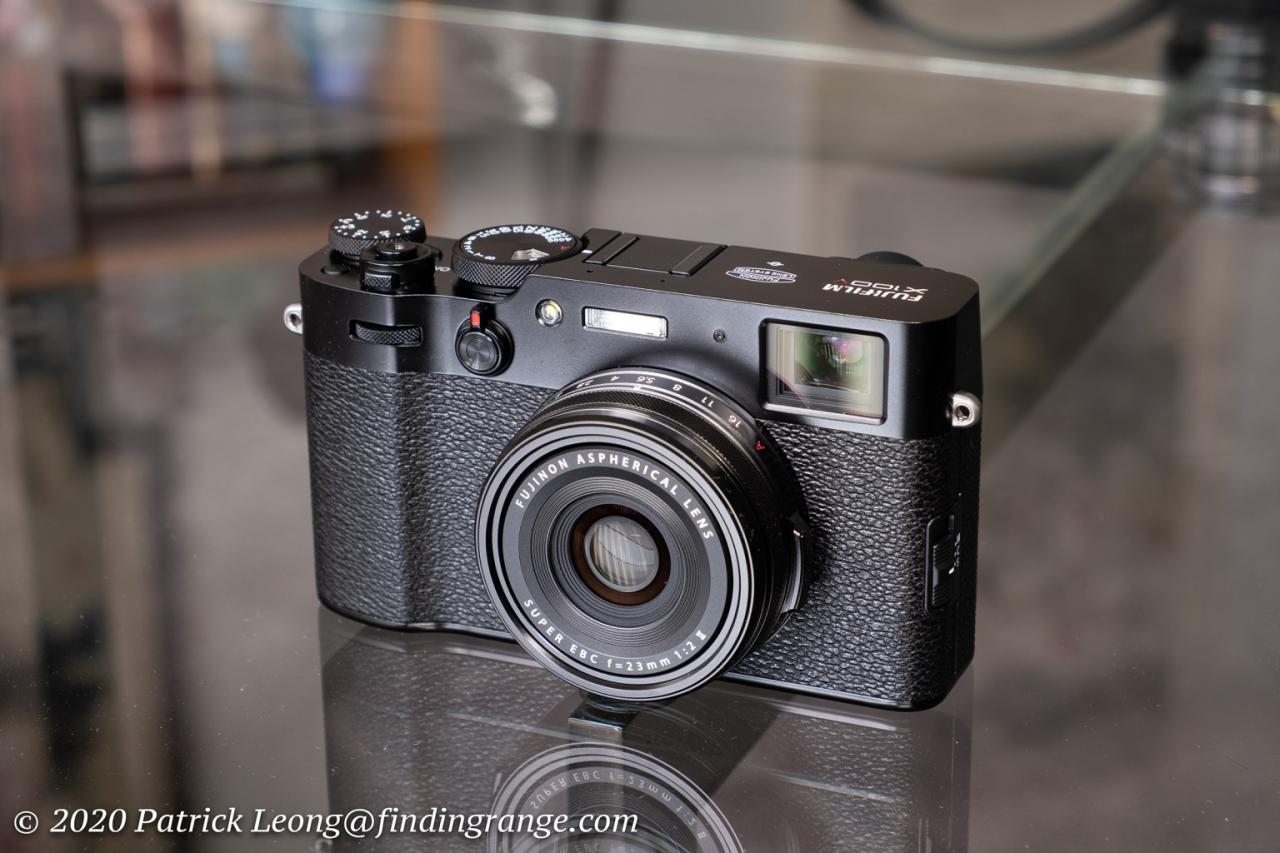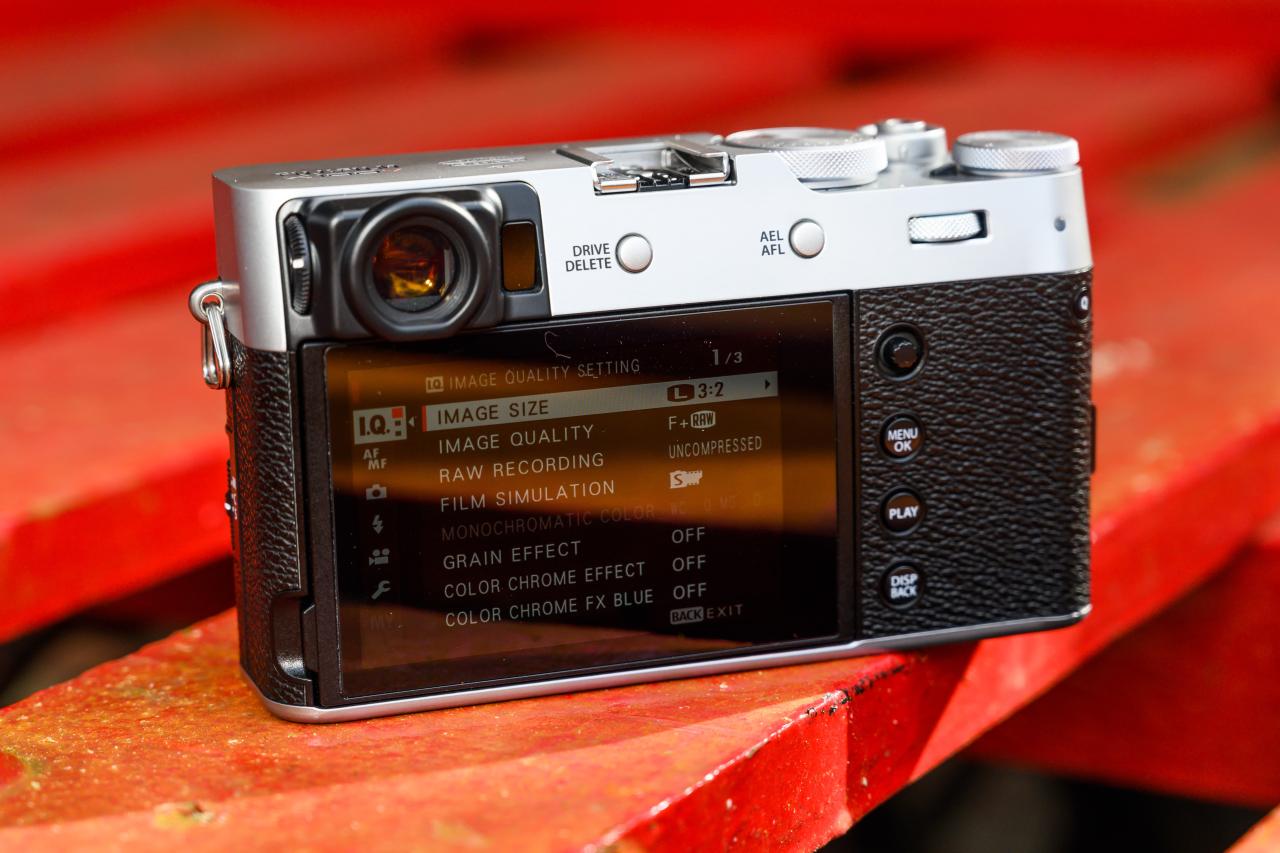Fujifilm X100V: The compact camera that punches above its weight. This review delves into the X100V’s impressive feature set, exploring its image quality, ergonomics, and versatile lens. We’ll examine its performance in various shooting scenarios, compare it to competitors, and ultimately assess whether it lives up to the hype surrounding this iconic camera.
From its retro-inspired design to its advanced autofocus system, the X100V offers a unique blend of classic aesthetics and modern technology. We’ll dissect its strengths and weaknesses, providing a balanced perspective to help you decide if this camera is the right fit for your photographic journey.
Image Quality and Performance

The Fujifilm X100V’s image quality is a significant selling point, largely due to its 26.1MP X-Trans CMOS 4 sensor. This sensor, combined with the camera’s X-Processor 4 image processing engine, delivers exceptional detail, dynamic range, and color reproduction, making it a compelling choice for photographers seeking high-quality stills in a compact package. The sensor’s unique design minimizes the appearance of moiré and false colors, common issues with traditional Bayer sensor arrangements.The X100V’s sensor performance translates to excellent image quality across a range of shooting conditions.
Sensor Impact on Image Quality
The X-Trans CMOS 4 sensor’s unique color filter array is key to the X100V’s superior image quality. Unlike traditional Bayer sensors, the X-Trans arrangement uses a more randomized pattern, effectively reducing the need for an optical low-pass filter (OLPF). This omission allows for sharper images with finer detail, particularly noticeable when capturing textures and fine lines. The higher resolution also provides greater flexibility in post-processing, allowing for more aggressive cropping without significant loss of detail.
Furthermore, the sensor’s improved light gathering capabilities contribute to better low-light performance, producing cleaner images with less noise.
Situations Where the X100V Excels
The X100V shines in various photographic scenarios. Its compact size and discreet design make it ideal for street photography, allowing for candid shots without drawing undue attention. The high-resolution sensor and fast lens capture exceptional detail in architectural photography, perfectly rendering intricate building facades and textures. The camera’s excellent dynamic range proves beneficial in high-contrast scenes, such as landscapes with bright skies and dark shadows, preserving detail in both highlights and shadows.
Its ability to handle a wide range of ISO settings makes it suitable for low-light situations, such as dimly lit interiors or night scenes, without excessive noise. Finally, the X100V’s ability to shoot RAW files provides photographers with significant flexibility for post-processing adjustments.
Autofocus System Performance, Fujifilm x100v
The X100V boasts a significantly improved autofocus system compared to its predecessors. Utilizing phase-detection pixels on the sensor, it offers faster and more accurate autofocus performance, particularly in challenging lighting conditions. While the single-lens design might seem limiting, the autofocus system’s speed and accuracy make it surprisingly effective for various subjects, from stationary objects to moving people. The system’s ability to accurately track moving subjects is enhanced by various autofocus modes, including continuous autofocus (AF-C) and subject tracking, ensuring sharp focus even with unpredictable movement.
The improved autofocus algorithm minimizes hunting and ensures quicker acquisition of focus, even in low-light scenarios.
The Fujifilm X100V, with its renowned image quality and compact design, is a favorite among street photographers. Its versatility extends beyond typical uses; for instance, if you’re looking for professional camera repair services near Port Dover, you might check out port dover camera to ensure your X100V remains in top condition. Returning to the camera itself, the X100V’s intuitive controls make it a joy to use, regardless of your skill level.
Dynamic Range and Color Reproduction
The X100V’s dynamic range is exceptionally wide, capturing a broad range of tones from deep shadows to bright highlights. This allows for greater flexibility in post-processing, enabling photographers to recover detail in both underexposed and overexposed areas. The camera’s film simulations, emulating classic Fujifilm film stocks, offer a distinctive look and feel, accurately reproducing colors with a natural and pleasing aesthetic.
These simulations allow for creative control over the final image, providing distinct color palettes and tonal characteristics that enhance the overall visual impact. For example, the “Classic Chrome” simulation provides muted tones and subtle color saturation, while “Velvia” offers vibrant and saturated colors. These diverse options provide a unique stylistic advantage, enhancing the creative potential of the camera.
The Fujifilm X100V, with its exceptional image quality, is a photographer’s dream. Its compact size makes it perfect for capturing spontaneous moments, much like the agility showcased by the innovative aircraft designs from archer aviation , which inspire similar feelings of sleek efficiency. Returning to the X100V, its retro aesthetic adds to its charm, making it a truly satisfying camera to use.
Lens and Functionality: Fujifilm X100v

The Fujifilm X100V’s defining characteristic is its fixed 23mm f/2 lens. This focal length, equivalent to approximately 35mm on a full-frame camera, makes it exceptionally versatile for a wide range of photographic genres, from street photography and landscapes to portraits and even some close-up work. The fast f/2 aperture allows for shallow depth of field and excellent low-light performance, contributing significantly to the camera’s overall appeal.The fixed lens design is a key element of the X100V’s identity.
It necessitates a different approach to photography, encouraging photographers to move their feet and compose carefully, rather than relying on zoom capabilities. This fosters a more considered and deliberate style of image-making.
Fixed Lens Advantages and Disadvantages
A fixed lens camera like the X100V offers several advantages. The fixed lens design often results in superior image quality due to the potential for higher precision optics and fewer moving parts. This contributes to sharper images and reduced distortion compared to many zoom lenses. The compact size and weight are also significant advantages, promoting portability and ease of use.
However, the lack of zoom functionality is a clear disadvantage. Photographers are limited to a single focal length, requiring them to adjust their position or use alternative techniques to achieve different compositions. This limitation can be creatively challenging but might restrict versatility in certain shooting scenarios.
Lens Sharpness and Distortion Compared to Competitors
The X100V’s 23mm f/2 lens is widely praised for its sharpness, particularly in the center of the frame. While edge sharpness might not be quite as exceptional as the center, it’s still generally considered very good. Compared to similar lenses in other compact cameras, such as the Ricoh GR III’s 28mm or the Sony RX1R II’s 35mm, the X100V’s lens holds its own, offering comparable sharpness and often less distortion.
Distortion is minimal in the X100V’s lens, with only subtle signs of barrel distortion at the edges, often easily corrected in post-processing.
Street Photography Workflow with the X100V
The X100V’s characteristics make it particularly well-suited to street photography. Its compact size and discreet design allow for unobtrusive shooting, while the 35mm equivalent focal length is ideal for capturing candid moments and environmental portraits. The fast aperture allows for shooting in low-light conditions often encountered in urban environments. A workflow for street photography using the X100V could include these steps:
- Preparation: Charge the battery, format the memory card, and select the desired shooting mode (Aperture Priority or Manual are recommended for greater control). Consider pre-setting your ISO to a relatively high value (e.g., ISO 800) for low-light situations.
- Location Scouting: Identify areas with interesting subjects and potential for compelling compositions. Consider the light and how it interacts with the environment.
- Shooting: Utilize the camera’s hybrid viewfinder (optical and electronic) to compose shots carefully. Experiment with different angles and perspectives. Take advantage of the fast autofocus to capture fleeting moments. Shoot in RAW format to retain maximum image quality for post-processing.
- Post-Processing: Import images to your computer, review and select the best shots. Use editing software (like Lightroom or Capture One) to adjust exposure, contrast, and sharpness. Correct any minor distortion if needed.
Image Examples and Descriptions

The following examples showcase the versatility of the Fujifilm X100V’s image quality across various shooting scenarios and demonstrate its capabilities in different lighting conditions and subject matters. These examples highlight the camera’s strengths in capturing detail, managing noise, and rendering colors accurately.
High-Contrast Black and White Image
This image depicts a stark cityscape at sunset. The scene is composed of tall buildings silhouetted against a vibrant, fiery sky. The strong contrast between the dark buildings and the bright sky creates a dramatic effect. The lighting is primarily backlighting, emphasizing the Artikels of the structures and casting long shadows. The film simulation used was “ACROS,” known for its smooth tonal gradations and rich blacks, perfectly suited to capture the high-contrast scene.
The result is a powerful image with deep blacks, crisp details in the brighter areas, and a classic, timeless feel characteristic of black and white photography. The composition is carefully balanced, with the buildings leading the eye towards the fiery sky, creating a visually compelling narrative.
Low-Light Image
This image shows a dimly lit street scene at night. Despite the low light, the X100V’s sensor performed admirably. While some noise is present, it’s relatively low, particularly considering the challenging lighting conditions. The noise is primarily fine-grained and doesn’t significantly detract from the image’s overall sharpness. Details remain visible, particularly in the brightly lit areas like street lamps and shop windows.
The sharpness is surprisingly good, with edges remaining well-defined even in the darker regions. The image successfully captures the atmosphere of the night, conveying a sense of quiet urban life.
Landscape Image
This landscape photograph features a rolling green hill dotted with sheep, extending to a distant mountain range under a clear blue sky. The depth of field is shallow, achieved using a relatively wide aperture, blurring the background slightly and drawing attention to the sheep in the foreground. This selective focus enhances the three-dimensionality of the scene. The color accuracy is excellent, with vibrant greens in the hills and a deep, rich blue in the sky.
The colors are natural and pleasing, without appearing overly saturated or artificial. The overall impression is one of serenity and natural beauty, accurately capturing the scene’s colors and depth.
The Fujifilm X100V stands as a testament to the power of a well-executed design. Its combination of exceptional image quality, intuitive controls, and a remarkably versatile lens makes it a compelling choice for photographers of all levels. While the fixed lens might be a limitation for some, the overall experience is undeniably rewarding. Whether you’re a seasoned professional or a passionate enthusiast, the X100V offers a unique and enjoyable photographic experience.
FAQ Insights
Is the Fujifilm X100V weather-sealed?
No, the X100V is not weather-sealed. Use caution in adverse weather conditions.
What video capabilities does the X100V offer?
It records 4K video at up to 30fps and 1080p at up to 120fps.
Does the X100V have image stabilization?
No, it relies on in-body image stabilization (IBIS).
What type of battery does it use?
It uses the NP-W126S battery.
